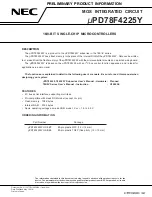
7.
Module Description
This section provides an overview of the major features of AT86RF212B. For detailed information, refer to Reference
guide - AT86RF212B section of the
.
7.1
Physical Layer Modes
7.1.1
Spreading, Modulation and Pulse Shaping
The AT86RF212B supports various physical layer (PHY) modes independent of the RF channel selection. Symbol
mapping along with chip spreading, modulation and pulse shaping are a part of the digital baseband processor as
shown in the following figure.
Figure 7-1. Base Band Transmitter Architecture
Symbol Mapping
and
Chip Spreading
Modulation
BPSK/O-QPSK
Pulse Shaping
DAC
PPDU
The combination of spreading, modulation and pulse shaping are restricted to several combinations, as shown in the
following table.
The AT86RF212B is fully compliant to the IEEE 802.15.4 low data rate modes of 20 kb/s or 40 kb/s, employing
binary phase-shift keying (BPSK) and spreading with a fixed chip rate of 300 kchip/s or 600 kchip/s, respectively. The
symbol rate is 20 ksymbol/s or 40 ksymbol/s, respectively. In both cases, pulse shaping is approximating a raised
cosine filter with roll-off factor 1.0 (RC-1.0).
For optional data rates according to IEEE 802.15.4-2006, offset quadrature phase-shift keying (O-QPSK) is
supported by the AT86RF212B with a fixed chip rate of either 400 kchip/s or 1000 kchip/s.
At a chip rate of 400 kchip/s, there is a choice between two different Pulse Shaping modes. One Pulse Shaping
mode uses a combination of both half-sine shaping (SIN) and raised cosine filtering with roll-off factor 0.2 (RC-0.2)
according to IEEE 802.15.4
‑
2006 [2] for the 868.3 MHz band. The other uses raised cosine filtering with roll-off factor
0.2 (RC
‑
0.2).
At a chip rate of 1000 kchip/s, pulse shaping is either half-sine filtering (SIN), as specified in IEEE 802.15.4-2006 [2],
or, alternatively, raised cosine filtering with roll-off factor 0.8 (RC-0.8), as specified in IEEE 802.15.4c
™
‑
2009 [3] and
IEEE 802.15.4-2011 [4].
For O-QPSK, the AT86RF212B supports spreading according to IEEE 802.15.4-2006 with data rates of either 100
kb/s or 250 kb/s depending on the chip rate, leading to a symbol rate of either 25 ksymbol/s or 62.5 ksymbol/s,
respectively.
Additionally, the AT86RF212B supports two more spreading codes for O-QPSK with shortened code lengths. This
leads to higher but non-IEEE 802.15.4-compliant data rates for PSDU transmission at 200, 400, 500 and 1000 kb/s.
Table 7-1. Modulation and Pulse Shaping
Modulation
Chip Rate
[kchip/s]
Supported Data Rate for
PPDU Header [kb/s]
Supported Data Rates for PSDU
[kb/s]
Pulse Shaping
BPSK
300
20
20
RC-1.0
600
40
40
(1)
RC-1.0
ATSAMR30M18A
Module Description
©
2018-2021 Microchip Technology Inc.
and its subsidiaries
Datasheet
DS70005384B-page 17
















































